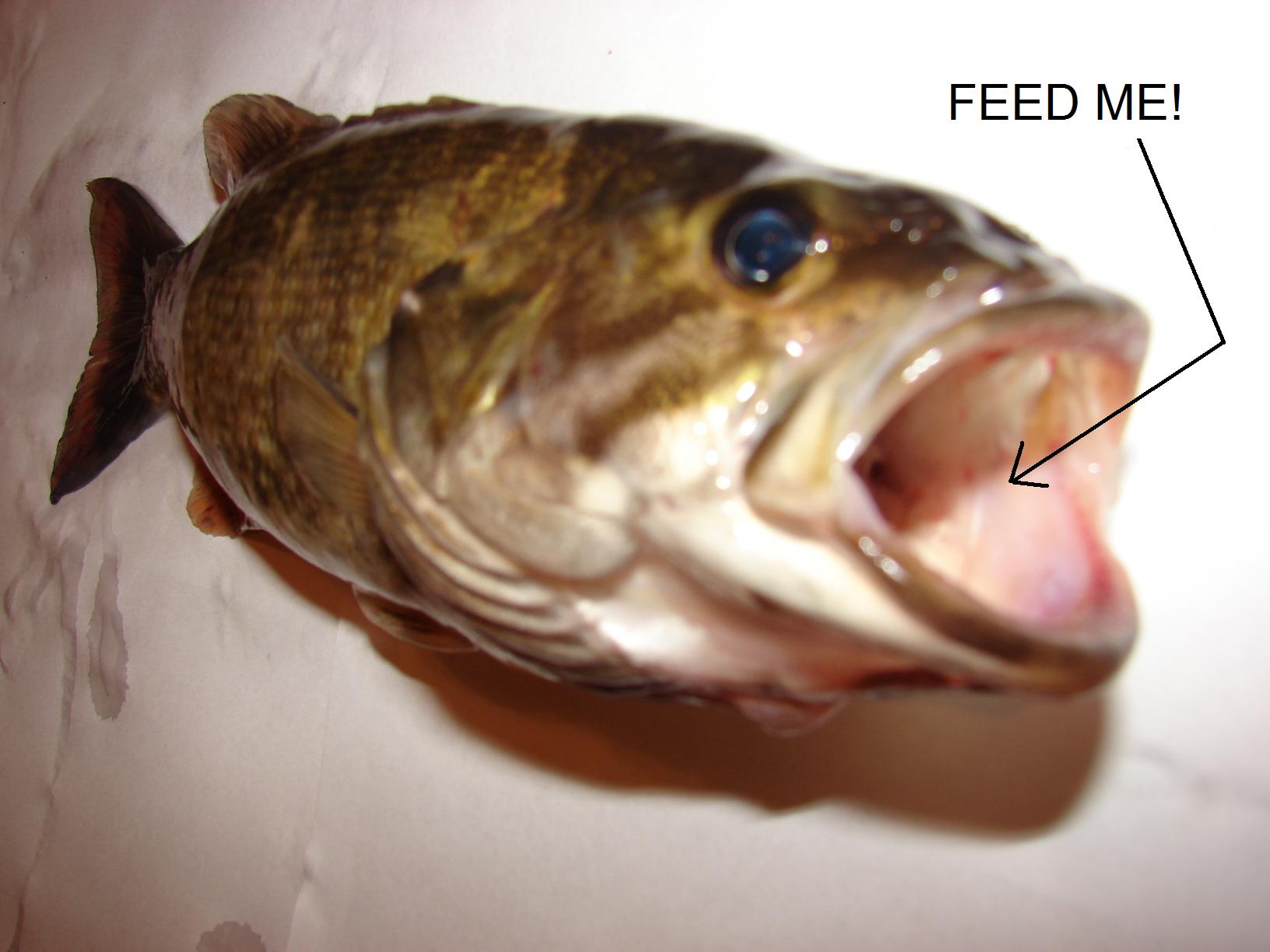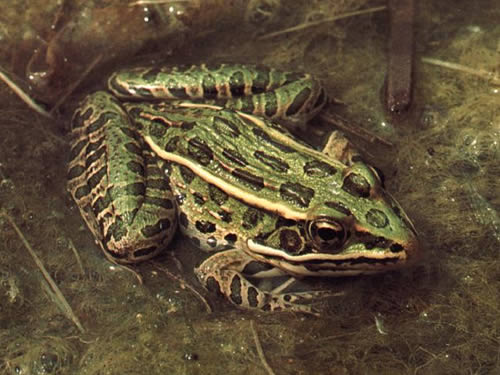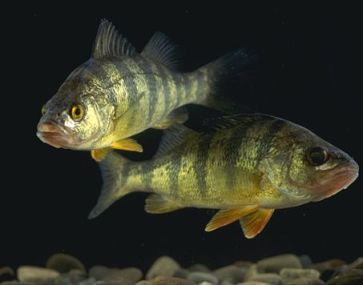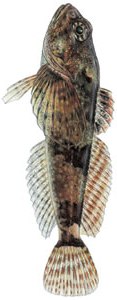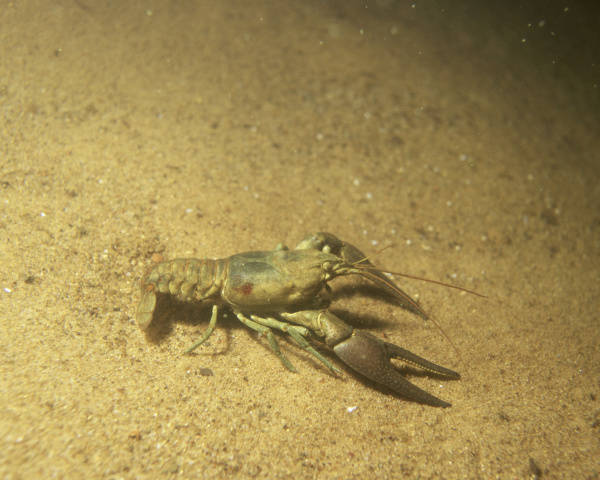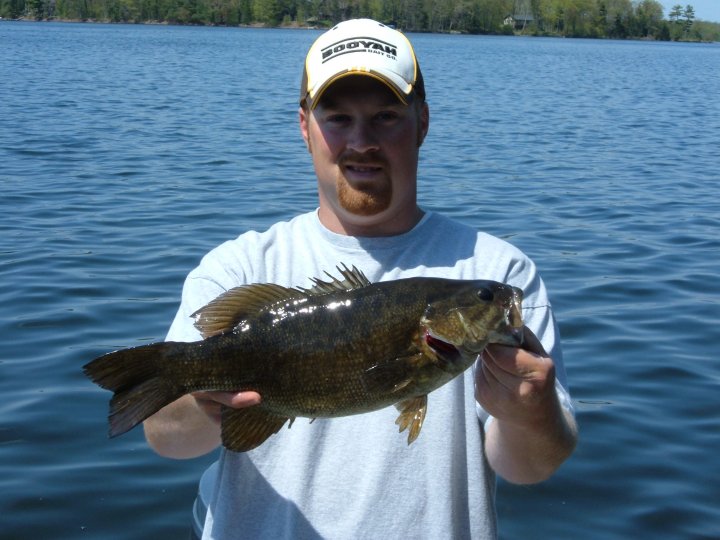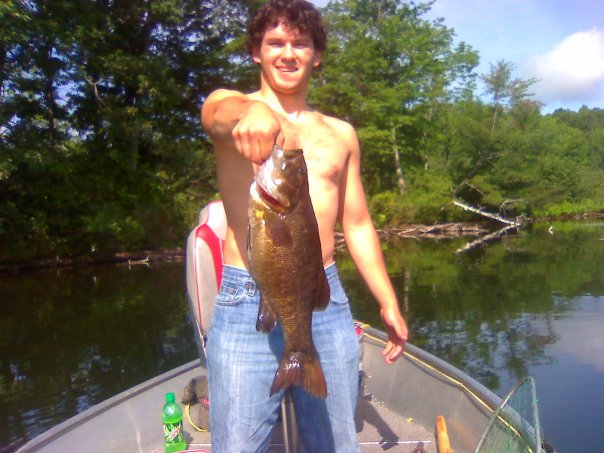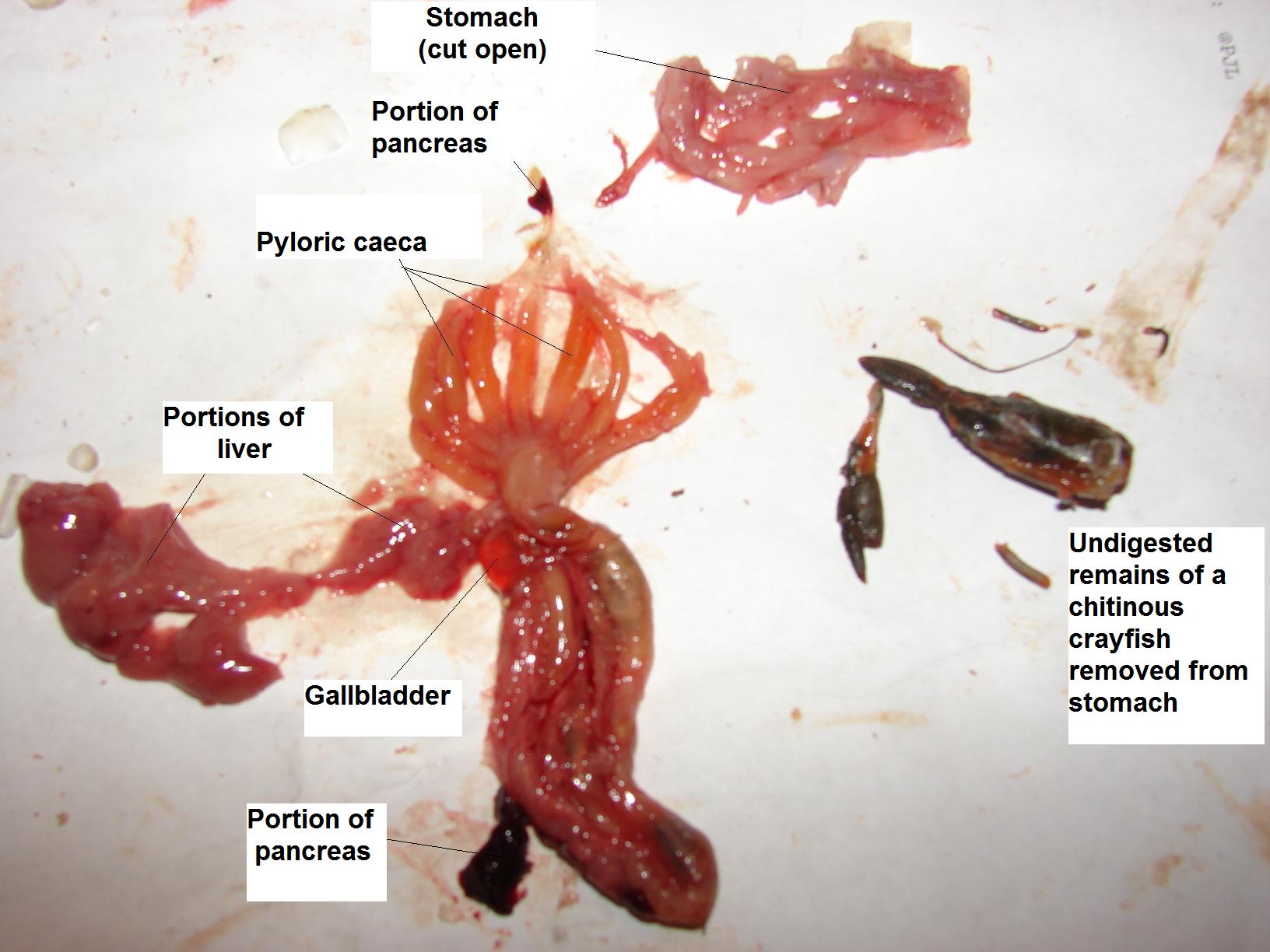SMALLMOUTH BASS
(Micropterus dolomieui)
Dustin Hetke
BIO 203: Organismal Biology, UW-La Crosse
Diet & metabolism
The need to feed is a definitive element of the smallmouth's
nature:
It is a heterotrophic animal, which means that it must obtain energy
by consuming other organisms. It is mostly a carnivorous predator;
however, because phytoplankton (microscopic aquatic plants and algae)
comprises a fair portion of its diet as a young fry, it is technically
considered
an omnivore.
The smallmouth’s diet is determined primarily by its age, size,
stage of
development, the relative abundance and distribution of food sources
found in various habitats, and the presence of other
predators competing
for the same prey. As one might expect, the size of the
smallmouth’s quarry generally increases as the bass grows larger and
matures into a more capable and established hunter. Details
concerning the physical and sensory adaptations of smallmouth, which are
engineered to maximize its efficiency of food capture, can be found
under Adaptive morphology & sensation.
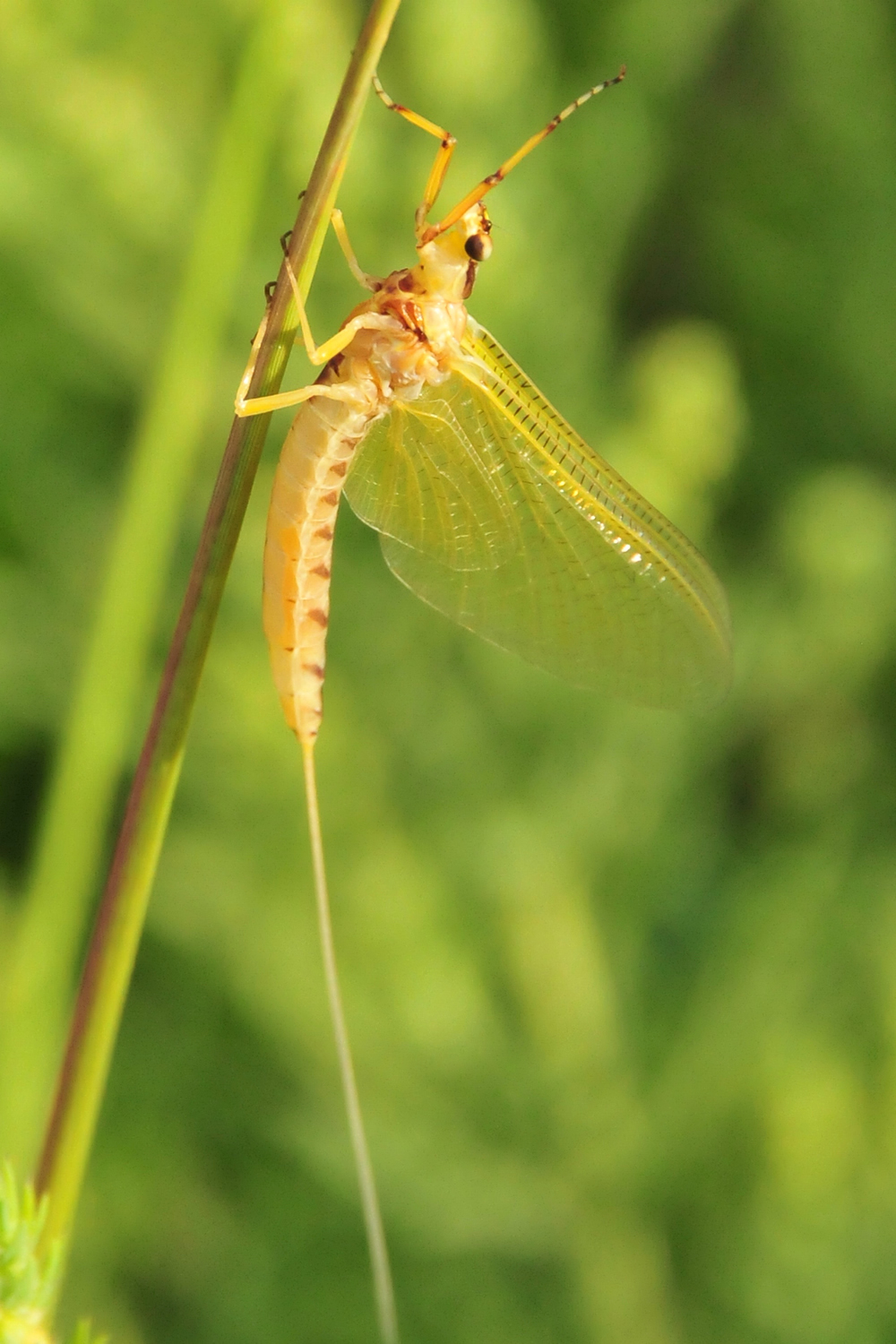 The nutritional needs of an embryonic smallmouth are met exclusively by
the yolk within its egg sac. About a week after hatching, the yolk
sac is gone, marking the beginning of predatory behavior. The
infant feeds mainly on aquatic microorganisms, those being phytoplankton
(diatoms, green algae)
The nutritional needs of an embryonic smallmouth are met exclusively by
the yolk within its egg sac. About a week after hatching, the yolk
sac is gone, marking the beginning of predatory behavior. The
infant feeds mainly on aquatic microorganisms, those being phytoplankton
(diatoms, green algae)
and zooplankton (microscopic animals like copepods,
water fleas, insect
larvae and nymphs, etc.). At this point, the infant remains very close to
its site of birth in shallow water,
where its consumption patterns run
parallel with that of the school of recently hatched
fry to which it
belongs. After dispersal from
the school, the young fry starts
feasting on a
more diverse supply of invertebrates,
expanding its diet to include a wealth of
full-sized insects and annelids (leeches and
worms).
Mayflies (photo at right) are an example of a
common insect prey item,
as are hellgrammites, stoneflies,
caddisflies,
and
damselflies.
As the juvenile grows, young crayfish become
a popular menu item,
along with an infusion of vertebrates that include tadpoles, frogs,
waterdogs, and almost any smaller fish. Furthermore, it may resort
to cannibalism of its smaller siblings if the opportunity presents
itself. The
Northern leopard frog (shown below) is a common choice
of amphibian prey for both juvenile and adult bass.
By early adulthood, the bass is a well-rounded and heavily-practiced piscivore, having developed into a relatively large fish that carnivorously feeds upon smaller fish on a routine basis. Bluegills, perch, shiners, smelt, and shad are its common fish prey in most natural lakes and highland reservoirs, while sculpin and suckers are often available to feast upon as they lurk the bottoms of many rivers and streams. Shown below are yellow perch (left) and banded sculpin (right):
Still, in virtually all smallmouth habitats, crayfish, which are crustaceans, are probably its most common choice of prey. This is based largely upon examinations of smallmouth stomach contents taken from lake, river, and reservoir specimens across the country. This assumption may be biased, however, for the chitin-rich exoskeleton of crayfish takes considerably longer to degrade and digest than the average fish that is swallowed. Thus, in terms of actual numbers eaten, the crayfish is not necessarily number one, even though it is widely accepted as the smallmouth’s favorite and most universal food source. To see what the undigested remains of a crayfish look like, before and after removal from the smallmouth’s stomach, scroll to the bottom of this page!
As exemplified by the vast number of diverse organisms that it normally consumes, the smallmouth bass is a feeding generalist during a fair majority of its life. More often than not, it is reluctant to travel great lengths across a lake or through a river current to find a tasty meal if a decent supply of other prey is available within a close range. Only during rather short-lived seasonal periods is the bass somewhat peculiar about what it eats. In this way, the smallmouth can benefit immensely from high levels of biodiversity within its ecosystem, as this means a wider array of potential prey to choose from. Furthermore, this can also reduce the effects of conflict between smallmouth and other predatory fish that would otherwise have to fight over a less plentiful supply of food.
Because it is ectothermic (cold-blooded), water temperature is a powerful influence on nearly every aspect of its behavior; its feeding habits are no exception. The bass is not equipped with any major means of maintaining a constant body temperature; as water temperatures go, the temperature of its closed circulatory system follows. This temperature dictates the rate at which vital biochemical reactions take place in the body, being faster when warmer and slower when colder; in short, these parameters define the smallmouth’s metabolism. Gaseous blood is pumped to the two-chambered heart via veins and away from the heart via arteries; these vessels form a single circuit that travels and loops through the length of the fish’s internal framework. Countercurrent exchange of oxygen and carbon dioxide occurs via capillaries within the gills.
As a positive consequence of being ectothermic, the smallmouth does not have to expend large amounts of energy to maintain a constant body temperature. This means that more of the energy obtained from food can be converted for purposes of increasing body mass compared to other animals that are warm-blooded (endothermic). Furthermore, this means the smallmouth can also survive longer periods of food abstinence if and when prey supply becomes scarce. As explained later, while smallmouth have no control over the temperature of the water they live in, they do exhibit seasonal movement that runs parallel with changes in water temperature, and therefore their ever-changing metabolism. On a short-term basis, the smallmouth bass can exercise a slight behavioral influence on its body temperature by moving from shallow surface water, which is exposed to more heat from sunlight, to deeper or more shaded areas, and vice versa.
The smallmouth’s quantity and frequency of prey consumption are geared to balance its energy intake with that expended. Its diverse diet provides a well-rounded supply of essential nutrients, including proteins (40-50%), carbohydrates, and lipids, along with several vitamins and minerals. Generally, energy is obtained from nutrients by breaking it down (catabolism), while energy is consumed by the synthesis of new molecules used in tissue growth and maintenance (anabolism), movement, respiration, and the numerous functions of other bodily systems. Because its metabolic rate fluctuates largely according to water temperature, many of its feeding patterns are governed by seasonal climate changes. Generally, colder water and shortened day lengths inhibit fish activity and energy expenditure, meaning the smallmouth will not necessarily have to feed very often; in contrast, warmer water temperatures and lengthened day lengths promote higher fish activity, leading to more energy expenditure and increasing the smallmouth’s need to feed. Corresponding with its metabolism, the smallmouth’s rate of digestion is highest in warm-water conditions (about 12 hours minimum) and lowest under cold-water conditions (up to four days).
In winter, when water temperatures range from about 35-45o F, natural smallmouth waters in northern regions are often are covered by a layer of ice. During this time, the smallmouth occupies deeper sanctuaries that carry sufficient levels of dissolved oxygen; its overall activity level, urge to feed, and growth rate are at an annual low. During the pre-spawn period (~46-55o F) of early to middle spring, increased daylight and warmer water temperatures gradually cause the fish to abandon its wintertime dwelling place for the likes of shallower depths. As spawning time draws near toward the end of spring, feeding activity and prey consumption often reach an annual high, as the fish prepares for the most stressful and energy-draining, yet absolutely essential, time of the year.
During the spawning period (~56-65o F), reproduction takes an
inherently clear priority over feeding. Frankly, energy
expenditure greatly exceeds prey consumption for smallmouth of both
sexes during this time. However, the male smallmouth will
viciously attack anything that jeopardizes the safety of the offspring
in his nest, which may be the only time that circumstances permit him to
feed. The female, after courting a male and laying its eggs, is
far too exhausted to think about eating. Immediately after the
rigors of reproduction is the post-spawn period, which usually occurs
when water temperatures begin to exceed about 65o F. The female
retreats to moderate depths for recuperation, while the male stays
behind to guard the small fry as they grow and develop in shallow
rearing areas. Frankly, energy expenditure greatly exceeds prey
consumption for smallmouth of both sexes during the
spawn.
Eventually, after the young smallmouth disperse and begin to fend for
themselves, both males and females have had a chance to rest, and as
water temperatures climb toward an annual high
(~70-80o F), good ol’
summertime sets in. Having been either too busy or too tired to
feed routinely since the onset of the spawn, the summer period is time
for the smallmouth to return to its aggressive predatory lifestyle.
As its metabolism spikes, the quantity and frequency of prey consumption
often soars much higher than energy expenditure, allowing for the
highest and most prolonged growth rates of the year.
The smallmouth’s food supply is usually most plentiful during the summer as well, as many species have also reproduced in large numbers upon completing their own respective spawning cycles. As fall arrives, water temperatures decrease again, in a manner reversed to the onset of spring; this cues the smallmouth to begin moving out toward deeper water, as its metabolic rate slows down. Having been fed upon routinely for most of the summer, prey populations are also greatly reduced by late autumn; the smallmouth will congregate with several others of its kind near drop-offs and underwater edges, where it will salvage what is left of its summer food supply before the cold-water winter season again takes precedence. After a few months, this ongoing seasonal cycle begins again. Because much of the smallmouth’s native range is found in the northern regions of America, winter acts as a limit to the fish’s annual growth rate. In comparison, growth rates found near the southern borders of its range are much higher. Ironically, these increased growth rates are associated with reduced life expectancies; therefore, getting bigger faster is not entirely beneficial to the smallmouth’s life longevity.
So, having covered the nuances of its diet, metabolism, and growth rate, what happens to the smallmouth’s food after it is eaten? The digestive system of a smallmouth bass can be broken down into several basic compartments. The size and extensiveness of each region, relative to that of other fishes, is modified to match accordingly with its mostly carnivorous diet. The labeled photograph shown below was taken after my dissection; click on it for a better view of the smallmouth's digestive components. Do you notice anything peculiar about its stomach?
The mouth functions in food acquisition, ingestion, and positioning of prey prior to entering the esophagus. The esophagus carries swallowed prey items from the buccal cavity toward the foregut (analogous to the stomach), where nutrient breakdown and absorption begin. In smallmouth and other fish that are primarily carnivorous feeders, the foregut is larger and more pronounced, providing ample space and expandability for storage of more numerous and larger prey items. Its inner walls secrete pepsinogens, which are enzymes responsible for protein breakdown, and hydrochloric acid, which creates a low-pH environment that is conducive for the activity of these enzymes. The intestinal tract, where most chemical breakdown and absorption of nutrients occur, includes the mid-gut (analogous to small intestines) and hindgut (analogous to the large intestines). In general, absorption entails the uptake of nutrients through the intestinal wall and into the bloodstream; from there, blood delivers the nutrients to the tissues that need them. The intestinal tract is relatively short and simple in comparison to that found in herbivorous fish; this is primarily because meat is generally more easily and efficiently digested than plant material. Much like humans, the intestinal tract of a smallmouth bass provides a relatively safe environment for many bacterial species to live in. These intestinal flora, in turn, possess digestive enzymes that aid the fish in digesting cellulose (from consumed plants) and chitin (crayfish and insect exoskeletons). This is a prime example of a mutually beneficial symbiotic relationship; see Interspecies relationship dynamics for more examples of interactions between smallmouth bass and other species. Distal to to the foregut is the mid-gut, which is jutted with un-branched extensions called pyloric caeca; these increase the amount of surface area available for nutrient absorption, particularly carbohydrates and fats. Unlike those found in largemouth bass, the pyloric caeca of smallmouth are not branched. The hindgut collects and tightly packs any remaining waste products that remain undigested prior to excretion through the vent (the anal and urogenetical opening). As shown in the photo below, the excretory vent is located on the smallmouth's ventral surface (belly), posterior to the pelvic fins and just a bit anterior to the anal fin:
The smallmouth’s digestive system is supplemented by a number of accessory (secondary) organs as well; these are not part of the gastrointestinal tract, but are integrated with it to perform important functions nonetheless. The smallmouth’s pancreas, upon detecting the ingestion of food, secretes various types of enzymes into the intestinal tract for the breakdown of virtually all nutrient molecules; it is found near the pyloric caeca of the mid-gut. The liver, which is located anterior to the foregut, provides a site for carbohydrate and lipid storage. It also produces bile, which is stored in a small sac called the gallbladder. Bile provides alkalinity to protect the intestinal tract from the acidic contents exiting the foregut, and facilitates detoxification of the blood through the removal of foreign toxins. Bile also serves to emulsify fats and lipids, increasing the exposed surface area of these molecules before lipase, the enzyme responsible for lipid breakdown, acts to deconstruct the lipids prior to absorption.
To cap this discussion of the smallmouth's digestive system, I have included another photograph from my dissection. Check out the undigested remains of that crayfish - is that cool or what? To get a better view, click on the picture.
Having learned the ins and outs of nutrient acquisition and digestion in smallmouth bass, feel free to proceed onward to learn about its reproductive behavior.
(Return to home page)
